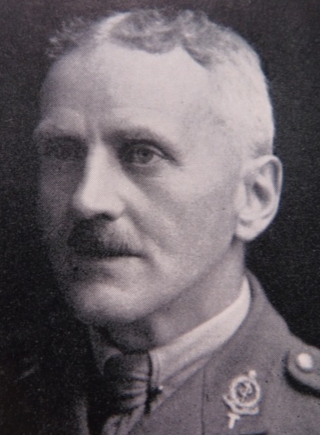Great War Dundee
This is Dundee's story of those that served in the First World War, and of the people left at home
We need you to tell us more about the life and times of James Samuel Yeaman Rogers
James Samuel Yeaman Rogers
Military Information
- Date of enlistment:
- Place of enlistment:
- Service no: N/A
- Rank: Lieutenant Colonel
- Service Occupation:
- Awards: Distinguished Service Order & Bar
- Regiment/Service: Royal Army Medical Corps
- Unit/Ship: Attached as Battalion Medical Officer to 4th Battalion, Black Watch
Personal Information
- Date of Birth: 21.06.1868
- Place of Birth: Rosemill, Strathmartine
- Address: Wellington House, 7 Wellington St, Dundee
- Occupation: Physician
- Mother:
Ellen Rogers nee Yeaman
- Father:
James S. Rogers
- Siblings:
- Spouse:
Mary Louisa Patullo (marraige 07.03.1900)
- Children:
- Age at Death: 80
- Date of Death: 13.06.1949
- Place of Death: Dundee
- Burial Country:
- Cemetery: Dundee Crematorium
More about James Samuel Yeaman Rogers
James was educated at Tay Square Academy, Dundee, and at Stanley House, Bridge of Allan. Thereafter, James Rogers attended Edinburgh University, where he graduated M.B., C.M. in 1890. “He was engaged in a colliery practice in Monmouthshire for a time” but, “in 1893, he started practice in Dundee, and was assistant physician in the Royal Infirmary”.
However, it was back in 1895 that his long connection with Volunteer and Territorial soldiering began. On 20 March 1895, he became a Surgeon Lieutenant in the 1st Volunteer Battalion (Dundee) The Royal Highlanders. By 25 January 1899, he was Surgeon Captain and, at the outbreak of war in August 1914, James Rogers was a Major, Royal Army Medical Corps, attached 4th (Territorial) Battalion, The Black Watch. In that year, he was awarded the Order of St John and, at some point in 1915, he was also to gain the Territorial Decoration.
Major Rogers went to the front with the original contingent of the 1/4th Black Watch. As such, he embarked at Southampton on 24 February 1915 and landed in France, the following day.
The “Fourth” received only a very short time to adjust to active service, before it was thrown into action. On 10 March 1915, it took part in the Battle of NEUVE CHAPELLE.
When wounded survivors of the battalion began to write home to Dundee about their experiences, it did not take long for the whole of the city to become aware of the devotion shown by “Surgeon-Major” Rogers. The following letter appears to be typical of these. It was written by Private P. Stewart of 52 Dudhope Street, and describes his experiences on 9 May 1915: “… Dr Rogers who was in the thick of it, and behaved like a perfect hero, dressed my wounds. He himself was slightly injured, but notwithstanding his wound he worked as though nothing had happened, and shells flying over his head all the time. If any one deserves distinction it is Dr Rogers…”
There is no doubt, therefore, that Major Rogers richly deserved a reward for his conduct throughout the three, actions he was involved in, namely : Neuve Chapelle, Aubers Ridge and Loos. In the event, he was to receive the Distinguished Service Order specifically for the Battle of Aubers Ridge: “… Near Rue du Bois during the attack on the 9th May 1915 he attended to the wounded under heavy shell fire, and with his own design short stretcher cleared many wounded out of the trenches. He was himself slightly wounded, but remained at duty.” His D.S.O., and a Mention in Despatches, were announced in January 1916. The following February.
On 5 September 1916, the 4/5th took over the line in the Hamel sector of the Somme and remained there until 12 September, when it went back to rest in Mailly Wood. “While resting here, Major Rogers and Captain Lyell were sent down the line…” No doubt exhausted, both physically and mentally, Major Rogers had more than earned a period of time, in which to recuperate. He was evacuated to the U.K., sick, on 23 September 1916 and remained on home service until he rejoined his unit, on 23 January 1917.
His next, known, battle was the major assault which opened the THIRD BATTLE OF YPRES. On 31 July 1917, the 4/5th Black Watch attacked “near St Julien” and remained in action until 6 August, having to endure constant shelling and repeated counter-attacks. “For his services on this occasion, Major Rogers, the Battalion Medical Officer, received a Bar to his D.S.O.”: “For conspicuous gallantry and devotion to duty. Throughout several days’ operations he attended to the wounded in the open under continuous heavy fire. Though all his stretcher-bearers were casualties, with utter disregard of danger he bound up the wounded and superintended their removal. His gallantry was most marked.”
Thereafter, the 4/5th served in the south-east sector of the Ypres Salient. On 26 September 1917, the battalion took part in an attack on the ridge to the left of TOWER HAMLETS, as part of the Battle of POLYGON WOOD. Over the next day and a half, the 4/5th Black Watch “lost heavily… and among those wounded was Major Rogers, R.A.M.C.”
Given his long, distinguished, service – and his age – it could have been argued at this point that Major Rogers had “done his bit”. And, indeed, on 8 June 1918, he was transferred to the 9th Black Watch Training Staff. Amazingly, though, he was hardly there for any length of time since, by 24 July 1918, he had rejoined the 4/5th. It would seem that he just could not stay away from his comrades and from his duty.
By this time, the 4/5th Black Watch was serving under French command, helping to repulse the German offensive in the area south of Soissons. Here, on 28 July 1918, Major Rogers took part in the capture of BUZANCY. In fact, the French were so impressed by this action at Buzancy that they erected a special memorial to the Scottish soldiers who had fought there. For his role in this battle, the French also rewarded Major Rogers with the Croix de Guerre with Palm, the translated citation for which reads: “On 28 July [1918] Major Rogers, who was in charge of the 4/5th Black Watch night and day, attended to all the wounded with infinite devotion, despite operating in a house that was particularly exposed to heavy shell fire. He voluntarily put his life at risk with the greatest self-control, in order to fully perform his duty. His devotion, along with his continuous cheerfulness, is deserving of the most wonderful praise from his superiors.” He had done it again: yet another decoration had been added to his list of honours. Moreover, the end of the war was now in sight and – as far as is known – he continued to serve right up to November 1918.
Looking back over his career, James Rogers seems to have led a charmed existence. Indeed, between 1915 and 1918, he came through many of the major actions of the war: Neuve Chapelle, Aubers Ridge, Loos, the Somme, Third Ypres and the Advance to Victory of 1918. That he wasn’t knocked out by bullets or shell-fire during any one of these, is almost a miracle. As it was, he was wounded twice: lightly, on 9 May 1915 and, it would appear, not seriously, on 26-27 September 1917. As for the tremendous nervous strain, he seems to have been affected only once, when he was “sent down the line” in September 1916. And, at the end, the 50-year-old James Rogers had collected a D.S.O., with a Bar, and the French Croix de Guerre. In fact, for his consistent gallantry during actions for which he received no reward, it could be argued that he richly deserved at least another two Bars to his D.S.O. Having finished his Great War service as a Lieutenant-Colonel, James Rogers returned to his doctor’s practice. He was still going strong in 1938, when the publication “Scottish Biographies” gave his address, still, as Wellington House, Dundee. His recreations were listed as “golf, fishing, shooting” and his Club as the “New, Dundee”. Moreover, by the later 1940s, “one of his last acts was to give £1,000 to the Dundee Branch of the British Legion to be held in trust, the income to be made available to aged members”. James Samuel Yeaman Rogers, the gallant and devoted Medical Officer of “Dundee’s Own” – and an exceptional and humane man – died on 13 June 1949 at Wellington House, 7 Wellington Street, Dundee. He was 80 years old and was still engaged, apparently, in being a “Medical Practitioner”.
Information very kindly supplied by Bill Longair and Jim Flood
Can you tell us more about James Samuel Yeaman Rogers'? Some additional facts, a small story handed down through the family or perhaps a picture or an heirloom you can share online. Contact our curator...

